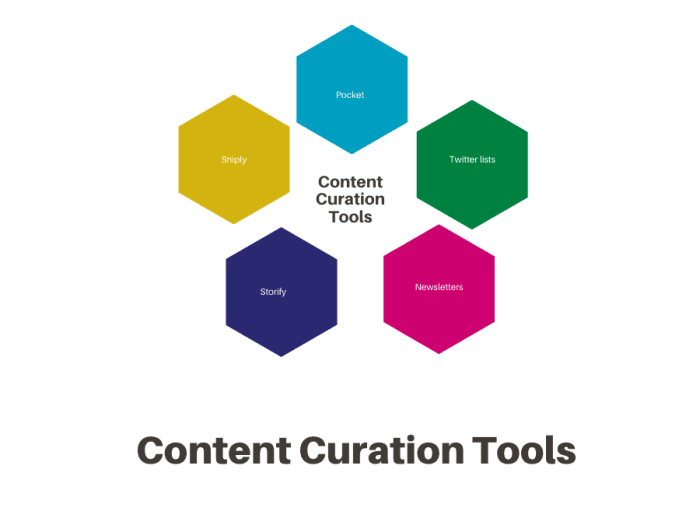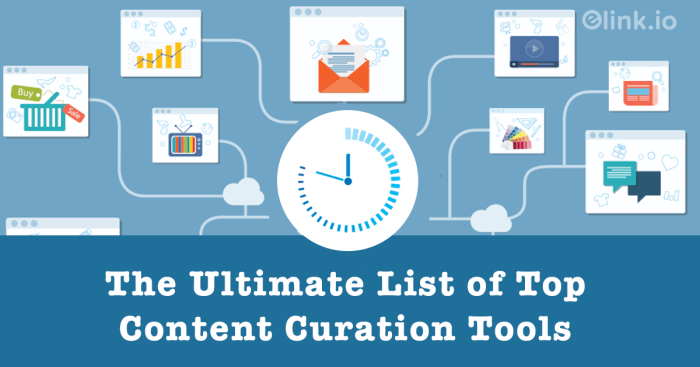Get ready to dive into the world of Content Curation Tools, where creativity meets strategy in the digital marketing realm. From organizing to engaging, these tools are your secret weapon.
Introduction to Content Curation Tools
Content curation tools are software or platforms designed to help marketers discover, gather, organize, and share relevant and valuable content from across the web. These tools play a crucial role in digital marketing by assisting businesses in creating engaging content for their target audience.
Importance of Content Curation Tools in Content Strategy
Content curation tools are essential in content strategy as they enable marketers to find high-quality content that resonates with their audience, saving time and effort in content creation. By leveraging these tools, businesses can maintain a consistent flow of valuable information to engage and attract customers.
Popular Content Curation Tools in the Market
- 1. Feedly: A popular tool for aggregating content from various sources and organizing them in one place for easy consumption.
- 2. Pocket: Allows users to save articles, videos, and other content to read or share later, making it a handy tool for content curation.
- 3. Curata: Known for its AI-powered content curation capabilities, Curata helps businesses discover and distribute relevant content efficiently.
- 4. Scoop.it: Enables users to curate content based on specific topics of interest, making it a valuable tool for niche content curation.
- 5. ContentGems: Helps users discover trending content based on their preferences and interests, making it easier to curate engaging materials.
Key Features of Content Curation Tools
Content curation tools offer a variety of features that make it easier to discover, organize, and manage content effectively. These tools are essential for content creators and marketers looking to streamline their content curation process.
Content Discovery
Content curation tools help users discover relevant content from a wide range of sources such as social media, news websites, blogs, and more. These tools use algorithms and filters to find content that matches specific s, topics, or trends, making it easier to stay updated with the latest information in a particular industry or niche.
Content Organization
One of the key features of content curation tools is the ability to organize and categorize content efficiently. Users can create custom folders, tags, or playlists to categorize content based on different criteria such as topic, publication date, or relevance. This helps in maintaining a structured library of curated content for easy reference and sharing.
Content Management
Content curation tools provide users with a centralized platform to manage all curated content in one place. Users can edit, schedule, and publish curated content directly from the tool, saving time and effort in the content distribution process. Additionally, these tools often offer collaboration features that allow multiple team members to work together on curating and publishing content seamlessly.
Content Recommendations
Some content curation tools leverage machine learning and artificial intelligence to provide personalized content recommendations based on user preferences and behavior. By analyzing user interactions with curated content, these tools can suggest relevant articles, videos, or resources that are likely to resonate with the target audience, enhancing engagement and driving traffic to the curated content.
Types of Content Curation Tools

When it comes to content curation tools, there are different types available that cater to various functionalities and user needs. Let’s explore and compare some of these types to understand their unique features and benefits.
Social Media Aggregators
Social media aggregators are tools that help users collect and organize content from various social media platforms in one place. They allow users to monitor multiple social media channels simultaneously and curate content based on specific s or hashtags. Examples of social media aggregators include Hootsuite, Buffer, and Sprout Social. These tools are often used by social media managers and marketers to streamline their content curation process and engage with their audience effectively.
Content Curation Platforms
Content curation platforms are comprehensive tools that enable users to discover, curate, and publish content from different sources. These platforms often offer features like content recommendations, content scheduling, and analytics to help users create curated content easily. Examples of content curation platforms include Curata, Scoop.it, and Feedly. These tools are popular among content marketers, bloggers, and publishers looking to curate relevant content for their audience.
RSS Feed Readers, Content Curation Tools
RSS feed readers are tools that allow users to subscribe to multiple websites and blogs and aggregate their content in one place. Users can organize and categorize their subscriptions, making it easier to access and curate content from different sources. Examples of RSS feed readers include Feedly, Inoreader, and Flipboard. These tools are commonly used by individuals who want to stay updated with the latest content from their favorite websites and blogs.
Bookmarking Tools
Bookmarking tools are tools that help users save and organize web content for future reference. Users can bookmark websites, articles, and videos they find interesting and categorize them into different folders or tags. Examples of bookmarking tools include Pocket, Diigo, and Raindrop.io. These tools are ideal for individuals who want to curate content for personal use or share with others.
Email Newsletters Services
Email newsletter services are tools that enable users to curate and distribute content via email newsletters. Users can create visually appealing newsletters, add curated content, and send them to their subscribers’ inbox. Examples of email newsletter services include Mailchimp, Constant Contact, and ConvertKit. These tools are commonly used by businesses and bloggers to curate content and engage with their audience through email marketing campaigns.
Benefits of Using Content Curation Tools

Content curation tools offer a myriad of advantages for businesses looking to enhance their marketing strategies. Let’s dive into the key benefits of incorporating these tools into your content creation process.
Time-saving Content Creation
Content curation tools can significantly reduce the time spent on researching and producing original content. By leveraging these tools, marketers can easily discover relevant and high-quality content from various sources, curate it, and share it with their audience. This streamlined process allows for a more efficient content creation workflow, freeing up time for other essential tasks.
Improved Content Quality and Engagement
One of the major benefits of using content curation tools is the ability to enhance the overall quality of your content. These tools enable marketers to access a wide range of valuable content curated by experts in the industry. By sharing curated content that resonates with your target audience, you can increase engagement and establish your brand as a thought leader in your niche.
Additionally, curated content can spark conversations, encourage discussions, and drive meaningful interactions with your audience.
Cost-effective Marketing Strategy
Incorporating content curation tools into your marketing strategy can also lead to cost savings. Instead of investing heavily in creating original content from scratch, you can leverage curated content to supplement your existing content strategy. This not only helps in reducing production costs but also allows you to maintain a consistent flow of content without compromising on quality.
Enhanced Performance
Content curation tools can also play a crucial role in improving your website’s performance. By regularly sharing curated content that is relevant and valuable to your target audience, you can attract more organic traffic to your site. Search engines value fresh and high-quality content, and by curating content from reputable sources, you can enhance your website’s credibility and visibility in search engine results.
Best Practices for Utilizing Content Curation Tools
When it comes to making the most out of content curation tools, there are some key practices to keep in mind. By following these tips, you can ensure that your curated content is effective, ethical, and seamlessly integrated with your original content.
Curate Relevant and High-Quality Content
- Focus on curating content that is relevant to your audience and aligns with your brand’s values and goals.
- Choose high-quality sources to ensure that the content you share is accurate and reliable.
- Avoid sharing content that is outdated or misleading to maintain credibility.
Give Proper Credit and Attribute Sources
- Always give credit to the original creators of the content you curate by including proper attribution.
- Respect copyright laws and only share content that you have the right to use.
- Provide links back to the original source to give readers the opportunity for further exploration.
Create a Balance Between Curated and Original Content
- Integrate your curated content seamlessly with your original content to create a cohesive content strategy.
- Avoid overwhelming your audience with too much curated content and strive for a balance that highlights your unique perspective.
- Use curated content to supplement your original ideas and provide additional value to your audience.
